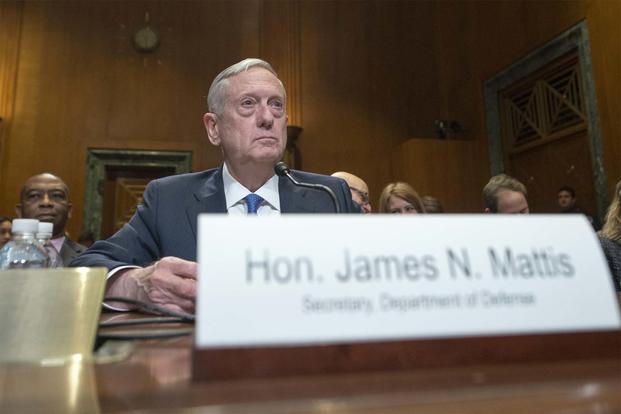Defense Secretary Jim Mattis is beginning a weeklong push on Capitol Hill for more defense spending and the lifting of budget caps with an unusual nighttime appearance before the House Armed Services Committee on Monday evening.
In line with his oft-stated commitment to "accelerate" military campaigns, Mattis is expected to use his testimony to back the long-standing request of Army Gen. John Nicholson, the U.S. commander in Afghanistan, for at least 3,000 more troops to battle the Islamic State and a resurgent Taliban.
The Trump administration has yet to sign off on the request, which would boost the U.S. troop presence in Afghanistan to about 11,500, compared to more than 100,000 before the drawdown ordered by former President Barack Obama. NATO and coalition allies have a total of about 5,000 troops in Afghanistan.
In testimony through Thursday before several defense committees, Mattis, accompanied by Joint Chiefs Chairman Marine Gen. Joseph Dunford, could be drawn into a battle for the State Department's budget as well as his own.
Related content:
- Trump Budget Calls for 2.1% Military Pay Raise in 2018
- Trump's Defense Spending Boost Faces Fight in Congress
- Readiness, ISIS Fight Come First for Mattis in Rebuilding Military
A number of retired generals and admirals, including Army Gens. David Petraeus and Stanley McChrystal, are expected to submit a paper to the Senate Armed Services Committee on Tuesday arguing that Trump administration proposals to slash State Department funding would hamper military operations.
Mattis has long taken the position that the work of the State Department and its Agency for International Development is complementary to the military's role. As commander of U.S. Central Command, Mattis famously told a congressional committee that if the State Department budget were to be cut, "I have to buy more ammunition."
Mattis and Dunford are set to appear at 7 p.m. Monday before the House Armed Services Committee; 9:30 a.m. Tuesday before the Senate Armed Services Committee; 10:30 a.m. Wednesday before the Senate Appropriations Committee's defense subcommittee; and 10 a.m. Thursday before the House Appropriations Committee's defense subcommittee.
The flurry of appearances is the result of the Trump administration's delayed submission of a proposed overall federal budget of $1.1 trillion in late May and the push by Congress to come up with a fiscal 2018 defense budget on time. The fiscal 2017 defense budget was not approved until April of this year -- seven months late.
The Trump administration has proposed a $603 billion defense budget, plus another $65 billion for the so-called "war budget" of Overseas Contingency Operations, for a total of $668 billion.
House and Senate Republicans are on record saying the $603 billion budget is not enough to meet emerging threats and boost readiness. Rep. Mac Thornberry, R-Texas and chairman of HASC, has called for a baseline budget of at least $640 billion, or $37 billion more than proposed by the Trump administration.
In February, Mattis began lobbying for more defense spending and lifting the sequester process' budget caps. He put readiness and "accelerating" the campaign against ISIS at the top of his wish list in his first budget guidance to the force on complying with President Donald Trump's executive order to rebuild the military.
At the time, Mattis said there were three priorities in order of importance: improve warfighting readiness; address pressing shortfalls; and "build a larger, more capable and more lethal joint force."
-- Richard Sisk can be reached at Richard.Sisk@Military.com.
Related Video:




























